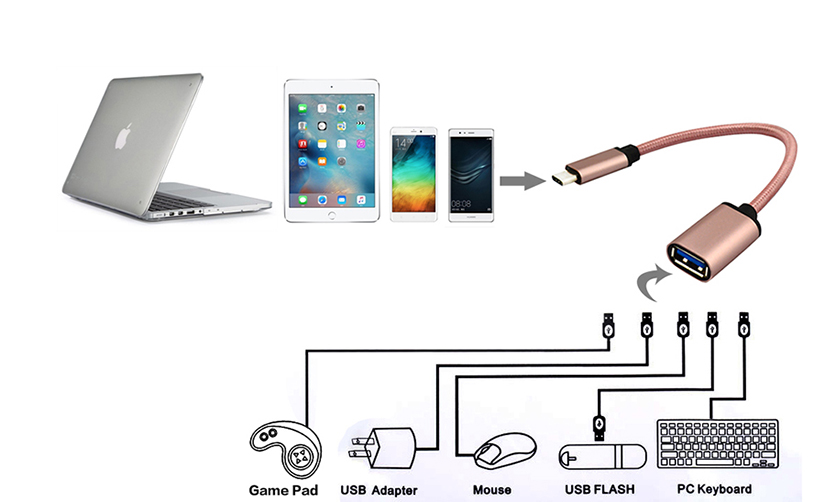USB OTG Cable
USB On-The-Go, often abbreviated to USB OTG or just OTG, is a specification first used in late 2001 that allows USB devices, such as tablets or smartphones, to act as a host, allowing other USB devices, such as USB flash drives, digital cameras, mice or keyboards, to be attached to them. Use of USB OTG allows those devices to switch back and forth between the roles of host and device. For instance, a mobile phone may read from removable media as the host device, but present itself as a USB Mass Storage Device when connected to a host computer.
In other words, USB OTG introduces the concept of a device performing both master and slave roles – whenever two USB devices are connected and one of them is a USB OTG device, they establish a communication link. The device controlling the link is called the master or host, while the other is called the slave or peripheral.

Overview
Standard USB uses a master/slave architecture; a host acts as the master device for the entire bus, and a USB device acts as a slave. If implementing standard USB, devices must assume one role or the other, with computers generally set up as hosts, while (for example) printers normally function as slaves. In the absence of USB OTG, cell phones often implemented slave functionality to allow easy transfer of data to and from computers. Such phones, as slaves, could not readily be connected to printers as they also implemented the slave role. USB OTG directly addresses this issue.
When a device is plugged into the USB bus, the master device, or host, sets up communications with the device and handles service provisioning (the host's software enables or does the needed data-handling such as file managing or other desired kind of data communication or function). That allows the devices to be greatly simplified compared to the host; for example, a mouse contains very little logic and relies on the host to do almost all of the work. The host controls all data transfers over the bus, with the devices capable only of signalling (when polled) that they require attention. To transfer data between two devices, for example from a phone to a printer, the host first reads the data from one device, then writes it to the other.
While the master-slave arrangement works for some devices, many devices can act either as master or as slave depending on what else shares the bus. For instance, a computer printer is normally a slave device, but when a USB flash drive containing images is plugged into the printer's USB port with no computer present (or at least turned off), it would be useful for the printer to take on the role of host, allowing it to communicate with the flash drive directly and to print images from it.
USB OTG recognizes that a device can perform both master and slave roles, and so subtly changes the terminology. With OTG, a device can be either a host when acting as a link master, or a "peripheral" when acting as a link slave. The choice between host and peripheral roles is handled entirely by which end of the cable the device is connected to. The device connected to the "A" end of the cable at start-up, known as the "A-device", acts as the default host, while the "B" end acts as the default peripheral, known as the "B-device".
After initial startup, setup for the bus operates as it does with the normal USB standard, with the A-device setting up the B-device and managing all communications. However, when the same A-device is plugged into another USB system or a dedicated host becomes available, it can become a slave.
USB OTG does not preclude using a USB hub, but it describes host-peripheral role swapping only for the case of a one-to-one connection where two OTG devices are directly connected. Role swapping does not work through a standard hub, as one device will act as a host and the other as a peripheral until they are disconnected.
Specifications
USB OTG is a part of a supplement to the Universal Serial Bus (USB) 2.0 specification originally agreed upon in late 2001 and later revised.The latest version of the supplement also defines behavior for an Embedded Host which has targeted abilities and the same USB Standard-A port used by PCs.
SuperSpeed OTG devices, Embedded Hosts and peripherals are supported through the USB OTG and Embedded Host Supplement to the USB 3.0 specification.

 Email
Email Asking price
Asking price